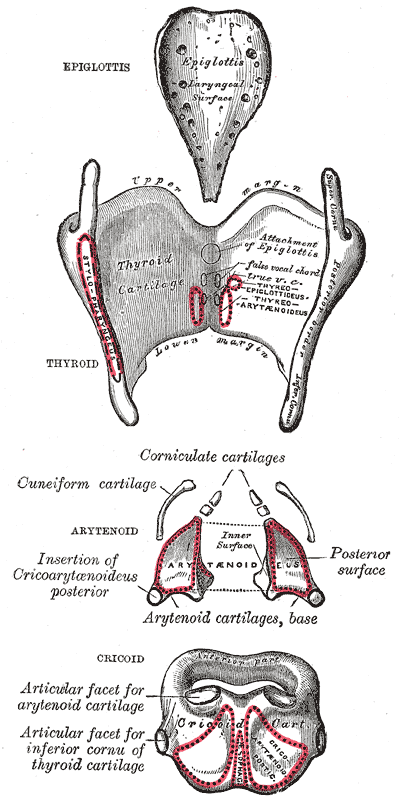So far I have only received the cricoid ring, and it's actually made out of hyaline cartilage. Hyaline cartilage is the type of cartilage found in the nose, and on the ribs for reference, so it's quite durable. The cricoid, is the only fully circular cartilage of the larynx, so it's quite ingenious of the designers at Krikeoeides to make a ring based off the cricoid.
The thickness of the ring varies, so it gives the piece some dimensionality which is an A+ in my books. Anteriorly, the ring is shorter and thicker; while posteriorly, the ring is taller and thinner. The ring looks amazing, and it makes a great statement piece that's sure to strike up a very phonetic conversation.

I can't wait for the other pieces to arrive. The other unpaired cartilages come in single statement pieces, so there is a piece each for the epiglottis and the thyroid cartilage. As for the three paired cartilages (making up the other 6 cartilages of the larynx), they come in earring sets! Krikoeides really thought things through when coming out with this larynx collection.
The epiglottis is a spoon shaped elastic cartilage, however other people have noted that it looks like a feather, and the main role of the epiglottis is to cover the glottis (opening into the larynx and lower airway) to prevent aspiration during swallowing. The design of the (on the)glottis pendent is striking, since there is enough slack in the chain to enable you to layer other long necklaces with this pendent. The designers took the more feather like approach to give the pendent a more whimsical look, rather than an ice cream scoop. However, I think if the Krikoeides designers were in the kitchen appliance industry, an epiglottis shaped ice cream scoop would have been the way to go. And it could be thermo-sensitive, since the epiglottis has tastebuds on it and the colour change could simulate this interesting tidbit. Anyways, that was a bit on a tangent, so let's get back to the topic of this post. Larynx cartilage based jewelry, and up next we have the last unpaired cartilage, the thyroid!
The thyroid cartilage based bracelet cuff is seriously neat stuff. The bracelet itself is pretty hefty, which makes sense since the thyroid cartilage is one of the main structural components of the larynx, and acts as an attachment point for various membranes. Via the thyrohyoid membrane, the superior aspect of the thyroid cartilage (and inadvertently the larynx) is attached to the inferior portion of the hyoid bone. Also, the thyroid is the attachment point of the larynx to the hyoid bone via the thyrohyoid membrane. Inferiorly, the thyroid cartilage is attached to the superior portion of the cricoid cartilage by the median and lateral cricothyroid ligaments. The cricothyroid muscle also spans this region, and is important in narrowing the space between the cricoid and thyroid cartilages to that the vocal folds can be tensed. My favourite thing about this bracelet is the protuberance on the front that mimics the laryngeal prominence (aka the adam's apple). This bracelet could do some serious damage so don't get on my bad side!
Moving onto the 3 paired cartilages, we have the arytenoids, corniculates and cuneiforms. The designers decided to make two pairs of earrings based off of these cartilages. The first set utilizes the pyramidal shape of the arytenoid cartilages, and articulating on the apexes of the arytenoids are small horn like prominences to serve as the corniculate cartilages, also known as the cartilages of Santorini. These earrings definitely catch your attention because of the unique shape of the arytenoids, but I somewhat wish Krikeoides designed a pair of earrings showing the cricoarytenoid joint.
This joint within the larynx is a highly mobile synovial joint, and the arytenoids sit at a 45 degree angle on the cricoid cartilage. Movement is permitted in three planes due to the unique placement of the arytenoids: they can slide medially and laterally, twist along their vertical axis, as well as rotate along the oblique axis in a rocking like motion. All these movements act to change the positioning and tension of the vocal folds, so if they had a pair of earrings like this I'm sure I could spend hours fiddling around with the various positions the cricoarytenoid joint allows.
As for the pair of earings based off the cuneiform elastic cartilages, also known as the cartilages of Wrisberg. Within the larynx, the cuneiform cartilages can be found the in aryepiglottic folds, so they do not directly articulate with the other two paired cartilages However, they still move with the arytenoid and corniculates during vocal fold adduction and abduction. These stud like earrings are wedged shaped and fairly elongated, which you don't see in many designs. I'm excited to see how these will fit, I mean will the look better as a helix stud or would they be better situated on my earlobe. Decisions, decisions, decisions...
Well hopefully this post has entertained you, and has amped you up for this jewelry collection! I seriously can't wait to get the rest of the shipment in, but for now I will admire the cricoid ring that I have and voice my enthusiasm to anyone willing to listen. ____________________________________________________________________________
References:
1. Hammer, G, Windisch G, Prodinger P, Anderhuber F, Friedric G. The Cricothyroid Joint - Functional Aspects with Regard to Different Types of Its Structure. Journal of Voice. 2010;24(2):140-145.
2. Sellars I, Sellars S. Cricoarytenoid joint structure and function. The Journal of Laryngology & Otology. 1983;97(11):1027-1034.